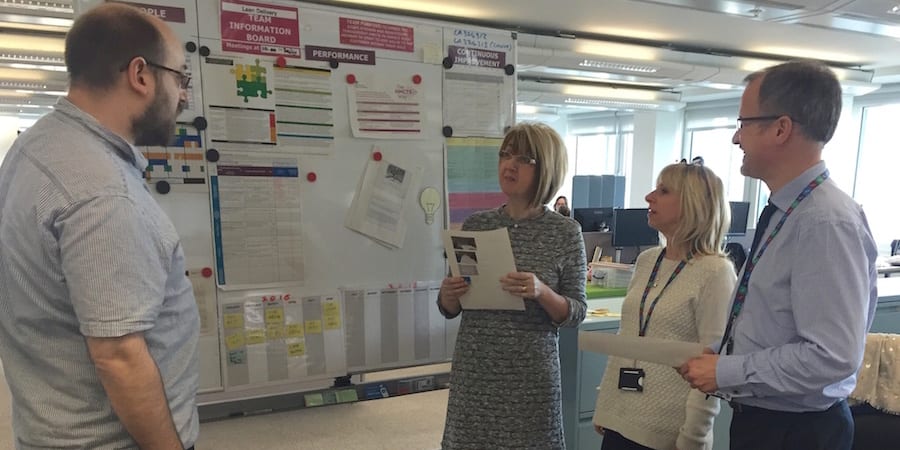
The serial improver: changing government with lean thinking
PROFILE – Lean leaders are often tempted to jump in and fix the problems they see. Julie McGrory is successfully transforming the culture of a large and traditional government organization by learning to take a step back and letting people take the lead.
Profile on: Julie McGrory, Head of Continuous Improvement, HM Courts and Tribunals Service
Words: Roberto Priolo, Editor, Planet Lean
I meet Julie McGrory on a gloomy January morning at the Ministry of Justice offices in central London. Before we head to a conference room for our interview, she insists on buying me a coffee.
While waiting in line at the cafeteria, McGrory leans over to tell me that the cafeteria has recently changed ownership and the way they serve people. There used to be one line, she explains, and they thought they could speed things up by creating a second one for people to pick up their beverage. “But, really, they just have two bottlenecks now and confusion on where to collect your drink from,” she says matter-of-factly, shaking her head.
A few minutes later, McGrory is telling me how these days she always looks for the waste around her, and how she rarely manages to refrain from saying something.
“I am truly awful to go out with. I see waste everywhere, in the waiting room at the hospital just like at the cafeteria downstairs, and then I coach people about it! Some people take it, others don’t… my hairdressers were all too happy to get help from me, and I had free haircuts for a couple years,” she says. “As a School Governor, following a critical OFSTED inspection, I ran a very useful problem solve on how to improve the Governing Body. This gave the Head Teacher a practical action plan for improvement.”
I suppose that when you have had to learn to see the waste in your own processes and work hard every day to eliminate it, it is difficult not to expect the same from others.
McGrory has worked for HMCTS for 26 years now. She started as an administrative officer at a court near where she lived, in Hitchin, Hertfordshire. She worked in a variety of leadership roles across the organization, whilst juggling family life. This got her to see different parts of the organization (there are three types of courts in the United Kingdom: Crown Courts, Magistrates Courts and County Courts) as well as HQ.
McGrory comments: “I was first introduced to lean when I was running the civil and family courts in Bedfordshire and North Hertfordshire. My Regional Director came for a visit and I was looking for a fresh challenge. He told me there was a new project kicking off. ‘It’s called lean. Have you ever heard of it?’ he asked me. I hadn’t, but before I knew it I became the first court manager to ever run a kaizen event within HMCTS.”
The improvement focused on the bailiff process. County Court Bailiffs collect money owed to companies or individuals on civil debt. Luton County Court had four bailiffs, who had to carry out 20 visits a day each.
McGrory thought she knew what bailiffs did, but admits she actually had no clue what her customers wanted from them. “Because ours was a rapid improvement event, we had changed the process quite significantly by the end of the week. We stopped bailiffs from repeatedly visiting defendants, as most of our customers did not want that service so office support was provided to allow contact via the telephone. Over time we also introduced a system to take payments over the phone. We truly revolutionized the system,” McGrory explains.
GROWING WITH LEAN
After seeing the potential of lean thinking and realizing that the service being provided to customers was quite different from what they wanted, McGrory “got the bug.”
Further opportunities to test the value of lean thinking in a government setting came when she was promoted to Head of Civil and Family at the Royal Courts of Justice in London. There, she found a very traditional environment.
MrGrory went in with enthusiasm and the determination to make things better, but ended up becoming the “new person who is changing everything.”
“To start with I didn’t even realize all my rapid improvement events were just tinkering. I just wanted to improve things, and I had become the ‘revolutionizer’,” she continues. “However, fixing a problem in one part of the system was creating problems elsewhere.” McGrory had something of an epiphany while working with a team who were changing the filing system in one of their Courts. She suddenly realized that her RIEs perhaps were not the right way to go and that they were actually causing lots of issues elsewhere for staff and customers. A Programme Board had been set up for the whole organization based on this approach. McGrory bravely had someone come in and teach them about value stream mapping and changed the approach taken on site.
One the most significant projects she took on in her career – and the first one she worked on as a true lean change agent – is perhaps the one with the Court of Protection (tasked with taking care of people who have lost their capacity), whose way of operating was completely transformed. By focusing on quality, cost and delivery, delays were reduced from 20+ weeks to six, problem-solving techniques were embedded to improve quality, and a third of the operating costs were removed. This left McGrory with a lasting understanding of why it’s always the system that requires change, and not the people (as Deming taught us). “Civil servants work really hard to deliver a service, and yet they end up creating so many workarounds to broken systems. If you invest time fixing the system by solving problems you’ll get the sustainable improvement the public seeks,” she says.
Those who know McGrory well are sometimes surprised at her advocacy of lean, but she sees this as a misunderstanding of what the methodology is. At its heart lean has respect for people and for their ability to solve problems for themselves and their customers. If your strategy allows for that to happen you will be on your way to developing the right culture for your organization.
In 2012, McGrory was given the role of Head of Lean for the whole of HMCTS.
SEEING THE WHOLE
McGrory says hers is a “big picture brain” and that she tends to see issues as a whole, but admits it was hard for her to realize that not everybody sees things the same way she does.
When she was taught VSM she felt like she finally had a tool to help others see the big picture, too. “I used to look at things in a way that others couldn’t understand,” she says, “I was able to see that there was a system, whereas civil service is all about seeing things in chunks.”
But that is not the only contribution that lean thinking gave to McGrory’s leadership style. It also taught her to listen to people more. As a driven and – by her own admission – rather bossy person, McGrory had to learn to adapt her style to the person she is dealing with. She is comfortable being called bossy if it is meant “in the same way my parents and teachers used with me.” That is, as a way of acknowledging the behavior of someone who can take control of a situation when needed, isn’t afraid to step up to the leader’s plate, and can energetically gather a diverse group of people around a good cause. Memories of being put in charge of teaching recorder lessons to her class, aged 10, as the teacher told her mother “McGrory can do it better than me” made a lasting impression.
“I have told people what to do for far too long,” she says. “I thought everybody was as keen to improve things as I was, and was surprised when I found out they weren’t. It got quite frustrating, and I learned a lot about how I could have done things differently: listening more and adjusting my pace. Some people just need more time.”
Indeed, change in government can take very long, and there is no doubt the slow pace is something McGrory struggles with. “I am very impatient, but when progress is sluggish it is important to remember you are not going to get wins every day, and that’s why you should celebrate each one you do get. But on the other hand, there is no point in improving and ‘winning’ if you don’t get people on board,” she says, before adding: “You need to understand how other people see it to help them to understand how you see it and get them to join you on the journey.”
For someone so focused on improving (remember the hairdresser?) that must have been quite a hard lesson to learn, but it is certainly one that McGrory is now using in the pursuit of change in a large, diverse and very traditional organization.
TO READ A CASE STUDY ON THE LEAN TRANSFORMATION OF HMCTS, CLICK HERE
PROFILE OF:

Read more


INTERVIEW – A 22-people veterinarian hospital in Barcelona has recently turned to lean thinking. We caught up with the owner to learn how things have changed six months into the journey.


INTERVIEW - Festo’s lean journey improved competitiveness by embedding Lean into daily operations, strengthening leadership engagement, accelerating innovation, and turning Bulgaria into an internal hub for innovation.


BUILDING BRIDGES – A member of the Theodo team tells us about their attempts to improve the performance of their Web apps using lean principles.


FEATURE – We are used to seeing the organization as a mechanical entity, but how can a machine possible change and improve? We must change our mental model and learn to see the lean enterprise as a growing plant.

